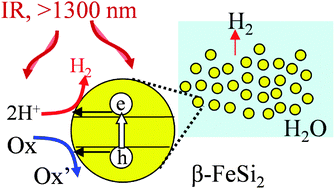Photocatalytic hydrogen evolution over β-iron silicide under infrared-light irradiation†
Abstract
We investigated the ability of β-iron silicide (β-FeSi2) to serve as a hydrogen (H2)-evolution photocatalyst due to the potential of its conduction band bottom, which may allow thermodynamically favorable H2 evolution in spite of its small band-gap of 0.80 eV. β-FeSi2 had an apparent quantum efficiency for H2 evolution of ∼24% up to 950 nm (near infrared light), in the presence of the dithionic acid ion (S2O62−) as a sacrificial agent. It was also sensitive to infrared light (>1300 nm) for H2 evolution.


 Please wait while we load your content...
Please wait while we load your content...